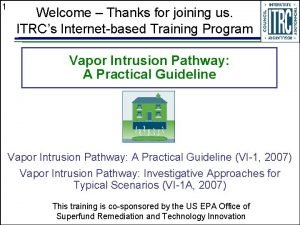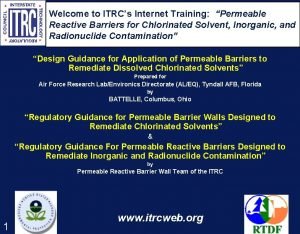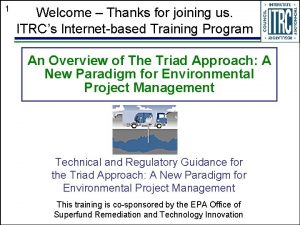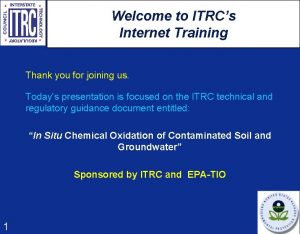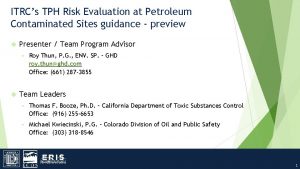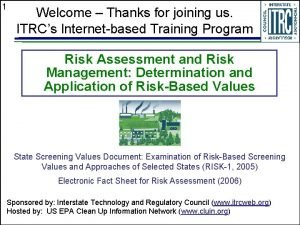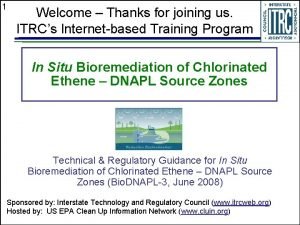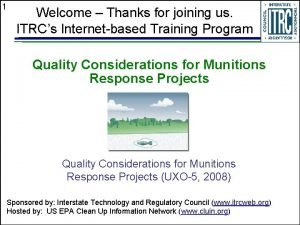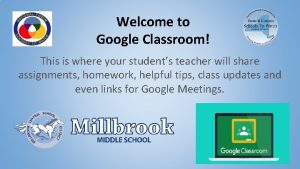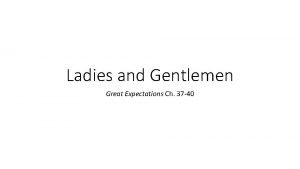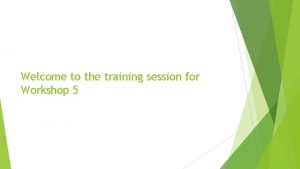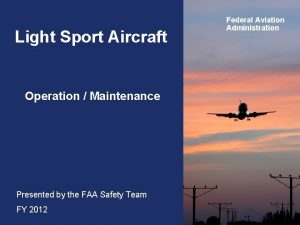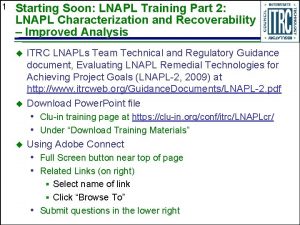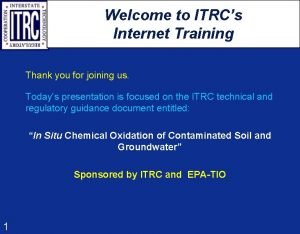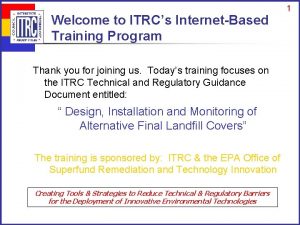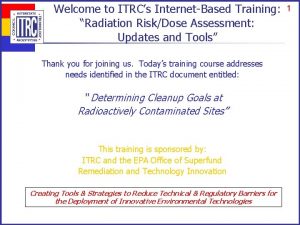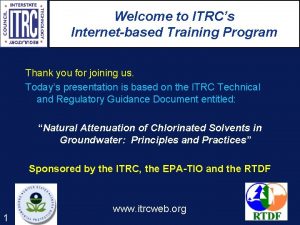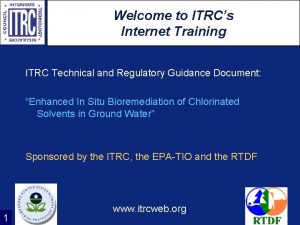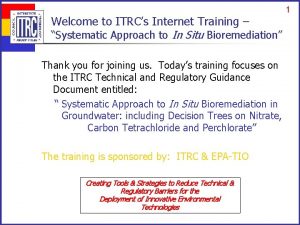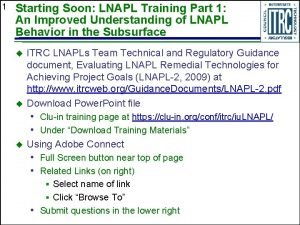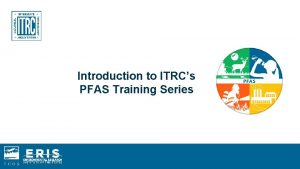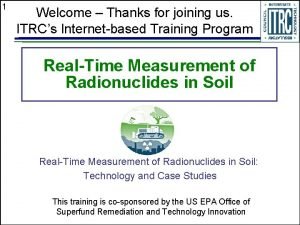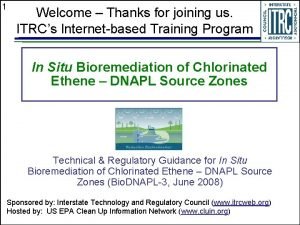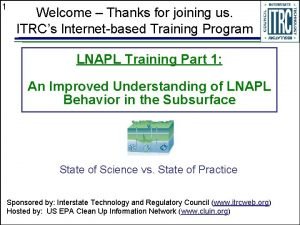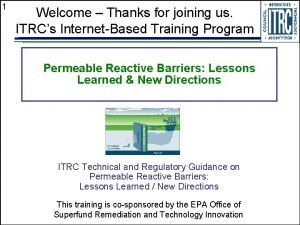1 Welcome to ITRCs LNAPL Classroom Training Light
























- Slides: 24

1 Welcome to ITRC‘s LNAPL Classroom Training Light, Nonaqueous-Phase Liquids: Science, Management, and Technology October 1 -2, 2013 Garden Grove, CA

2 ITRC (www. itrcweb. org) – Shaping the Future of Regulatory Acceptance u Host organization u Network u • • • State regulators § All 50 states, PR, DC • Federal partners u ITRC Wide variety of topics Technologies Approaches Contaminants Sites Products • Technical and regulatory DOE DOD EPA • ITRC Industry Affiliates Program • Academia • Community stakeholders guidance documents • Internet-based and classroom training

3 Light, Nonaqueous-Phase Liquids: Science, Management, and Technology Session 1 – Introduction

Introduction 4 This Course Will Give You the Opportunity to Develop Your LNAPL Expertise: u Build on your past LNAPL experience while learning new concepts and applying new tools u Learn along-side regulators, consultants, and industry participants with similar challenges u Apply ITRC’s science-based LNAPL tools and guidance u Prepare to ask the right questions and when to seek additional expertise at your sites u Prepare to apply your new knowledge at your sites

5 ITRC LNAPL Expertise Meet Your Instructors Pam Trowbridge Paul Stock Pennsylvania DEP Minnesota Pollution Control Agency Derek Tomlinson Terrence Johnson Geosyntec Consultants U. S. EPA Sanjay Garg Shell Global Solutions Mark Lyverse Chevron Energy Technology Company John Menatti Rick Ahlers Utah DEQ ARCADIS Andrew Kirkman BP

6 LNAPL Course Content u LNAPL behavior and assessment u LNAPL conceptual site model u LNAPL remedial objectives, goals and performance metrics u 17 LNAPL remedial technologies u ITRC’s Technical and Regulatory Guidance Document (Tech Reg)

7 Training will be a combination of: u Speaker presentations u Interactive “knowledge checks” u Practice application of concepts and tools The Plan • Individual and group exercises u Question and Answer Sessions Also: u Cover more than just what’s in the Tech Reg u Networking opportunities with regulators, consultants, and industry participants to share challenges and ideas

8 Regulatory Enforcement Our Class Ground Rules u Interactive – ask questions/discussion, but be mindful of the time u Be present and open-minded u Respect for all u Safety and comfort u Turn off or silence cell phones - calls in the hall u Do not use computers

9 Light Nonaqueous-Phase Liquid (LNAPL) – What is it? LNAPL Problems? Mixed component LNAPL – an immiscible organic liquid that is less dense than water e. g. , gasoline, diesel, lube oils, benzene Single component LNAPL Water Key Point: You will learn that although LNAPL floats neatly on water in a glass, it doesn’t behave as neatly in the subsurface LNAPL is also referred to as: product, free product, separatephase hydrocarbons, separate phase, phase-separated hydrocarbons, oily stuff in a well; elsewhere

10 LNAPL Problems? Are These LNAPL Sites?

11 LNAPL Problems? How Do You Remediate These Sites?

12 LNAPL Problems? What About What’s Left Behind?

13 LNAPL Problems? LNAPL Contamination in the News

14 ITRC’s LNAPL Team Published an LNAPL Remediation Decision Making Framework LNAPL Remedial Technologies for Achieving Project Goals (Dec 2009) ITRC LNAPL Expertise u Evaluating u Framework to systematically select LNAPL remedial technologies in context of LNAPL Conceptual Site Model (LCSM) Stakeholder and remedial objectives 2 Industry Representatives 8 Consultant 13 State Regulatory 15 Federal Agency 4

Tech Reg 15 The LNAPL Technical & Regulatory Guidance “Tech Reg” Contains… u Regulatory LNAPL management context (Section 2) u Key definitions and concepts (Section 3. 1, Table 3 -1) u A summary of subsurface LNAPL behavior (Section 3. 2) u Example LNAPL remedial objectives, goals and performance metrics (Section 4) u A technology selection framework (Section 5) u LNAPL screening tools (Sections 6 -8) u Summary facts and references for 17 technologies (Appendix A - Tables A, B, C) (p. A-1 – A-64) Key Point: The Tech Reg is a useful tool to inform yourself and guide LNAPL remedial decisions. Streamlines the remedy selection process.

16 Tech Reg Technology Series Tables Tech Reg Appendix A (p. A-1 to A-64) u A table series (Tables A, B and C) for each of the 17 LNAPL remediation technologies u • A-series – general technology information • B-series – evaluation factors • C-series – technical implementation considerations For a technology, the A, B and C tables are presented on consecutive pages u Key literature references presented in the tables u

17 Tech Reg Use Also Supported By: u An Improved Understanding of LNAPL Behavior in the Subsurface - State of the Science vs. State of the Practice (Online Training Part 1) u LNAPL Characterization and Recoverability – Improved Analysis (Online Training Part 2) u Evaluating LNAPL Remedial Technologies for Achieving Project Goals (Guidance Document & Online Training Part 3) u Evaluating Natural Source Zone Depletion at Sites with LNAPL (April 2009) (Document)

18 L nc NA ep PL Mo tua de l Si te l Co ASTM RTDF & es tiv jec rics Ob Met Synergy Is A Good Thing Blends Well With Other Resources ITRC, 2009 Evaluating LNAPL Remedial Technologies for Achieving Project Goals ITRC, 2009 Evaluating Natural Source Zone Depletion at Sites with LNAPL Technology Selection ASTM, 2006 Standard Guide for Development of Conceptual Site Models and Remedial Strategies for Light Nonaqueous-Phase Liquids Released to the Subsurface E 2531 -06 EPA RTDF, 2005 A Decision. Making Framework for Cleanup of Sites Impacted with Light Non. Aqueous Phase Liquids (LNAPL) EPA 542 -R-04 -011

19 Tech Reg Process Flow Diagram (Figure 5 -1, page 28) LNAPL characterization Develop LCSM IBT-1, 2 Section 3 Identify LNAPL concerns Section 6 Identify LNAPL objectives, goals, site/LNAPL condition to screen technologies (Screening Step 1: Table 6 -1) Tech Reg Screen technologies: Geology factors (Screening Step 2: Tables A) Screen technologies: Evaluation factors (Screening Step 3: Tables B) Section 7 Minimum data requirements and critical technology Group (Tables C) Section 8 Establish goals and metrics and implement LNAPL remediation Monitor/assess LNAPL remediation performance Demonstrate goals met

Learning Objectives 20 After This Class You Should Be Able to: u Develop and apply an LNAPL Conceptual Site Model (LCSM) u Understand assess LNAPL subsurface behavior u Develop and justify LNAPL remedial objectives including maximum extent practicable considerations u Select appropriate LNAPL remedial technologies and measure progress u Use ITRC’s science-based LNAPL guidance to efficiently move sites to closure

21 Our Hypothetical LNAPL Site Sharkey’s

22 Sharkey’s: Test Driving the Tech Reg u Apply concepts to develop the LCSM for Sharkey’s: • Apply site information to decide if LNAPL is present Sharkey’s • Determine LNAPL extent based on conventional data • Estimate LNAPL saturation u Evaluate LNAPL concerns and remediation objectives u Apply LNAPL transmissivity to decide optimum areas for potential LNAPL recovery u Choose LNAPL remedial technology

23 Sharkey’s: Overview Plan View A u MW-9 MW-10 Example Service Station MW-2 S. S. MW-3 Flow N MW-1 u u MW-5 MW-7 MW-4 MW-6 u MW-8 A’ u 100’ Old gasoline release • Release abated • UST system tight Geology: silty sand Depth to groundwater • Historical high: 27 ft bgs • Current: 32 ft bgs Max GW concentrations: • Benzene: up to 15 mg/l In-well LNAPL • 2005 : 0. 5 ft • 2006 -2009 : None • 2010 : 1 -3 ft

24 Silty Sand MW-8 MW-5 MW-1 MW-3 MW-2 10’ 20’ Historical GW Level 3 ft 30’ 40’ 1. 5 ft 100 ft 1 ft Current GW Level Silty Sand Example Service Station 0 MW-9 ft bgs Sharkey’s: Overview Cross Section A-A’
 Itrcs
Itrcs Itrcs
Itrcs Itrcs
Itrcs Industrial worker
Industrial worker Itrcs
Itrcs Itrcs
Itrcs Itrcs
Itrcs Itrcs
Itrcs Itrcs
Itrcs Light light light chapter 23
Light light light chapter 23 Into the light chapter 22
Into the light chapter 22 Light light light chapter 22
Light light light chapter 22 Smart classroom vs traditional classroom
Smart classroom vs traditional classroom Goole classroo,m
Goole classroo,m Gentleman in great expectations
Gentleman in great expectations Wise men three clever are we
Wise men three clever are we Adit exams
Adit exams Welcome to the training session
Welcome to the training session Put out the light, and then put out the light
Put out the light, and then put out the light Membrane-bound organelles
Membrane-bound organelles Or the bending of light and the bouncing off of light
Or the bending of light and the bouncing off of light Block light materials
Block light materials Light sport repairman training providers
Light sport repairman training providers Training is expensive without training it is more expensive
Training is expensive without training it is more expensive Perbedaan on the job training dan off the job training
Perbedaan on the job training dan off the job training
